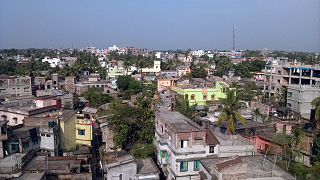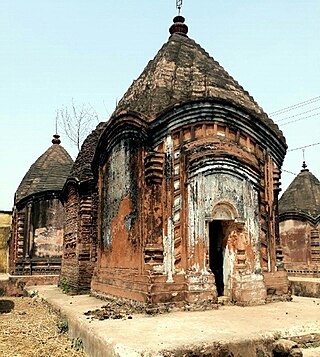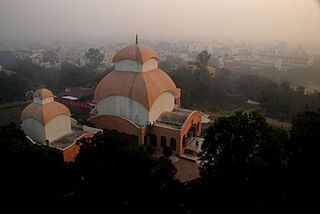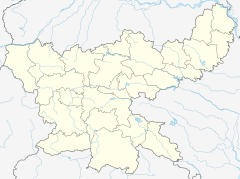
Parvati, Uma or Gauri is the Hindu goddess of power, energy, nourishment, harmony, love, beauty, devotion, and motherhood. She is a physical representation of Mahadevi in her complete form. She is also revered in her appearances as Durga and Kali. She is one of the central deities of the goddess-oriented sect called Shaktism, and the chief goddess in Shaivism. Along with Lakshmi and Saraswati, she forms the Tridevi.

Shaktism is one of several major Hindu denominations, wherein the metaphysical reality is considered metaphorically a woman and Shakti (Mahadevi) is regarded as the supreme godhead. It includes many goddesses, all considered aspects of the same supreme goddess. Shaktism has different sub-traditions, ranging from those focused on most worshipped Durga, gracious Parvati to that of fierce Kali.

Bardhaman is a city and municipality in the state of West Bengal, India. It is the headquarters of Purba Bardhaman district, having become a district capital during the period of British rule. Burdwan, an alternative name for the city, has remained in use since then.

Deoghar is a major city in Jharkhand, India. It is a holy sacred place of Hinduism. It is one of the 12 Jyotirlingas sites of Hinduism. The sacred temples of the city make this a place for pilgrimage and tourists. The city is administrative headquarter of Deoghar District at Santhal Parganas division of Jharkhand.

Dumka, the headquarters of the Dumka district and Santhal Pargana region, is a city in the state of Jharkhand, India. It was made the headquarters of the Santhal Pargana region, which was carved out of the Bhagalpur and Birbhum district after the Santal Hool of 1855. Dumka was carved out of the southern part of Bihar along with 18 other Districts on 15 November 2000 to form Jharkhand as 28th State of India. Dumka is a peaceful and green city and also sub-capital of Jharkhand. The nearest important cities are Rampurhat and Deoghar.

Bhadrakali, also known as Mahakali and Kali, is a Hindu goddess.

Kalna or Ambika Kalna is a town in the Purba Bardhaman district of West Bengal, India. It is the headquarters of the Kalna subdivision, situated on the western bank of the Bhāgirathi river. The town is more popularly known as Ambika Kalna, named after the goddess Kali, Maa Ambika. It has numerous historical monuments, such as the Rajbari, and 108 Shiva temples. The city of Kalna is 60 kilometres (37 mi) from Bardhaman.

Rampurhat is a city and a municipality in Birbhum district in the Indian state of West Bengal. It is the headquarters of the Rampurhat subdivision. According to Census 2011 Rampurhat is the third most populous city in Birbhum district and 82nd most populous city in West Bengal. Rampurhat is a rapidly growing township It is near the West Bengal / Jharkhand border. Rampuhat is an important city of Birbhum district as it has dynamic connectivity with the other places of West Bengal and neighboring states via state highways, national highway and rail route. Rampurhat Junction is one of the busiest railway stations in eastern India.

Tarapith is a 13-century Hindu temple in Chandipur village Rampurhat II CD block in Rampurhat subdivision of Birbhum district of the Indian state of West Bengal, known for its Tantric temple and its adjoining cremation grounds where sādhanā are performed. The Tantric Hindu temple is dedicated to the goddess Tara, a fearsome Tantric aspect of the Devi, the chief temples of Shaktism. Tarapith derives its name from its association as the most important centre of Tara worship.

Maluti is a village in Shikaripara CD block in the Dumka subdivision of the Dumka district of Jharkhand, India. It was built under the Baj Basanta dynasty. The area has 72 old temples, which are edifices to the kings of the Pala Dynasty. They portray various scenes from Hindu mythology including the Ramayana and the Mahabharata. Maluti is known for the annual sacrifice of over 100 goats on Kali Puja, besides one buffalo and a sheep. Animal activist groups have often strongly looked down at this activity. Today Maluti is endangered by insufficient management of the old temples, and threatened by natural disasters.

Kali, also referred to as Mahakali, Bhadrakali, and Kalika, is a Hindu goddess who is considered to be the goddess of ultimate power, time, destruction and change in Shaktism. In this tradition, she is considered as a ferocious form of goddess Mahadevi, the supreme of all powers, or the ultimate reality. She is the first of the ten Mahavidyas in the Hindu tantric tradition.

Bamakhyapa, born Bamacharan Chattopadhyay, was an Indian Hindu saint who is held in great reverence in Tarapith and whose shrine is also located in the vicinity of the Tara temple in Birbhum. He worshipped Maa Tara as if she was his own mother. He was born at Atla village in Rampurhat subdivision of Birbhum district.
Thillai Kali Temple is a Hindu Temple located on the outskirts of the town of Chidambaram, Cuddalore District Tamil Nadu in India. It was built by Chola King Kopperunjingan who ruled between 1229 and 1278.

Chittaranjan Park Kali Mandir is a temple complex and Bengali community cultural center in Chittaranjan Park in New Delhi, India. Built on a small hill, it started as a Shiv temple in 1973, which still stands within the complex, the larger shrines dedicated to goddess Kali, Shiva, and Radhakrishna were added in 1984. Over the years it has remained an important centre of convergence of local Bengali community during annual Durga Puja festivities.

Chhinnamastika Temple dedicated to Goddess Chinnamasta is a Hindu pilgrimage centre and located in Rajrappa, in Ramgarh district of Jharkhand, India. The place attracts devotees from all parts of Jharkhand, and also from the neighbouring states of West Bengal and Bihar.
Tourism in Jharkhand refers to tourism in the Indian state of Jharkhand. Jharkhand is known for its waterfalls, hills and holy places.

Shikaripara is a community development block in India that forms an administrative division in the Dumka Sadar subdivision of the Dumka district, Jharkhand state, India.
Lohapur is a village in Nalhati II CD block in Rampurhat subdivision of Birbhum district in the Indian state of West Bengal.

The Indian state, West Bengal has a rich and cultural heritage. Due to the reign of many different rulers in the past, arts and crafts in West Bengal underwent many changes giving an artistic diversity today in the forms of traditional handicrafts, terracotta, painting and carving, dances and music.






















